John Hurrell – 11 September, 2024
Now here in Starkwhite forty-nine years later, we see a 2020 image of Apple®, taken by Paul Johns (on Apple®'s instructions), that is hung several inches below that original mid-seventies height-line. Thus it now becomes a comment on aging and the harsh fact of spinal compression (ie. height shrinkage).
Up on the top floor, we see something special. Billy Apple’s well known self-portrait Billy Apple touring-poster image, made back in 1974. When first exhibited it was meant to focus on 5 foot, 7 and a half inches (his then height level when standing back against a wall, where an envisaged horizontal line would just touch the top of his head). This would give the viewer a sense of the experience of meeting Billy in person, face-to-face, establishing a physical context for the documentation image by marrying it to the architecture that sustained it in the space.
Now here in Starkwhite forty-nine years later, we see a 2020 image of Apple®, taken by Paul Johns (on Apple®’s instructions), that is hung several inches below that original mid-seventies height-line. Thus it now becomes a comment on aging and the harsh fact of spinal compression (ie. height shrinkage).
Personally, I found this installation of the 2020 Billy Apple® Self-Portrait incredibly moving, especially as he has been dead now for exactly three years. And of course greatly missed as an inspiration and role model for younger artists. The hang of the later image was planned by Apple®, who was very aware of the changes his body was going through—and who loved thinking-through finely tuned artwork presentation details.
In the large Starkwhite gallery below we find a selection of Progressives, 1962-67, printed lithographic self portraits on loose canvas, where the three colours (cyan, magenta and yellow) are kept apart to emphasise double overlaps, not triple ones. Black is rarely included.
These 1967 image pairs or triples (based on photos by Robert Freeman of the newly named Apple in 1962 with his newly peroxided hair; facing the camera, looking off to the right, or turning right around in order to look completely away), through consultations with printer Roy Crosset, emphasise multi-coloured divided selves—via blurred split faces on multiple canvases—all ostensibly featuring the one outwardly single recognisable body but implying also a range of possible new behaviours, new mindsets, new traits, tics and reflexes.
Sometines there is a bi-polar suggestion when the head is split, so that front and back views are juxtaposed tightly together. There are no left or right-facing side profiles. They would lack the direct psychological impact that front and back views have.
Highly ambiguous, these fuzzy visages suggest the complexity of an individual’s temporary moods over the course of a day or year, or more permanent socially distinctive personas that separate over a lifetime. The emotional properties of colour (though culturally specific) are showcased here, leading obviously to speculative interpretations. Clearly the hues are deliberately limited and within each work, not inclusive of an entire chromatic spectrum. Collectively they are like a true rainbow and so symbolically, have ‘progressive’ undercurrents of morphing sexualities and shifting genders.
Also the layering process causes the shape of Apple’s head to change from image to image. In some it even becomes compressed, thinner and slightly elongated. Maybe this reshaping implies reduced intellectual acumen, a ‘pinheading’ of the depicted individual. In contrast, a ‘fathead’ is a stupid fool, another abusive term more about temperament than paucity of thinking ability, for some others show his head to be wider. Strangely, these bizarre expansions or compressions don’t seem related to the direction of the roller on the lithographic printing plate. In a few his head looks creepily skull-like. In a handful, unexpected gridded patterns emerge.
In one work, three straight vertical beams of bright monocoloured light (butted together and of different thicknesses) traverse the unstretched canvas as if projected down from heaven, giving the Apple physiognomy a divine ordination, hinting perhaps at joy bestowed or something mystical like that described in the Biblical story of St. Paul’s revelatory experience on the road to Damascus. Or conversely, a blue beam seems to suggest a mood of depression, a sense of angst or debilitating alienation.
In other words all sorts of interpretative possibilities emerge regarding the new ‘deconstructed’ Apple head, many possibly unanticipated by the artist in these merging facial and cranial forms.
On the ground floor, we find fourteen Paid: The Artist has to Live Like Everybody Else works (2015-2021) that feature bills for art-presentation materials and routine living expenses—or train tickets—that fourteen people, other than the artist, have fiscally accounted for, in return for the now displayed documentation of the transaction as an Apple artwork. Nowhere is the spender/purchaser’s name mentioned on the document, so these works on paper become a form of ‘Apple’ tender and can be resold as an acquirable investment. They, like the Progressives, also can be seen as a form of self-portrait, looking at his personality, focussing on the stuff he buys, that he likes to work, entertain or surround himself with.
Extending this argument, you might argue that these particular works comment on the Self by scrutinising a particular kind of consumer, an ‘artificially’ created individual who happens (through manipulating the conventions of art ownership) to acquire without directly spending—leaving that necessity to others: proxy substitutes who are rewarded by Apple art ownership.
Some might say he is therefore a cunning trickster; in fact an exploiter of a capitalist system where prestige is granted to possessors of wealth normally acquired through their own or others’ labour, investment or inheritance, strategies which he here deftly circumvents. Instead, while not bartering in the usual sense of the word, and developing a negotiated form of gifting, he reaps the benefits through avoiding the conventional procedures of initiating ownership, or claiming original possession.
However also in this show there are works that extoll the value of outer surface, and open display—that avoid nuanced strategic agendas or clever conceptual footwork. Five Decades (82-91) is a 2012 ceramic apple (one of five) coated in gold paint that is very different from the solid cast apple of pure gold made in 1983—and pictured on the cover of the Wellington City Art Gallery publication, As Good As Gold: Billy Apple Art Transactions, 1981-1991. It is straight forward about its materiality through its label, so its value lies more in the significance of its marker pen signature, the written name ‘Billy’, and the wit of the ceramic object being a surname.
Layered in its possible meanings, the painted ceramic fruit repudiates an ‘authentic self’—exactly as you’d now expect from Apple with his interest in the complexities of identity, branding and desire—here revelling in its own very pointed construction, and its denial of any intrinsically embedded character. (Its colour is related to his acquisition of peroxided blonde hair when he made the name change in 1962—a similar symbolic gesture.) Its name thus implies the celebration of a manufactured personality, and through that, reminding us of an extraordinarily innovative art career and its continuing impact in the art world.
John Hurrell


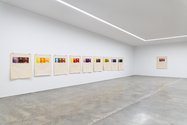
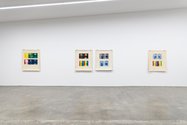
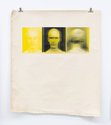
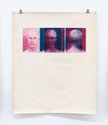


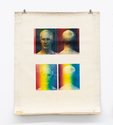
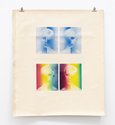




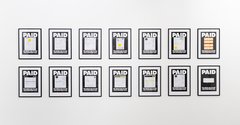
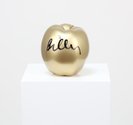
 Advertising in this column
Advertising in this column Two Rooms presents a program of residencies and projects
Two Rooms presents a program of residencies and projects



This Discussion has 0 comments.
Comment
Participate
Register to Participate.
Sign in
Sign in to an existing account.